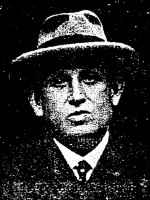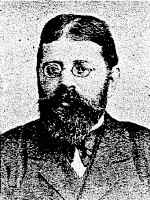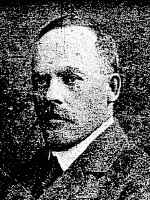
|

|

|
Josef Stein
Rb. Josef Adler
Josef Vogel
|
|
[Pages 687-689]
(Czech Republic: Dolní Kralovice – 49°40' 15°10', Vysoká Libyně – 50°01' 13°27')
Compiled by František Kolman, Dolní Kralovice (specialist subject teacher)
Translated from the original Czech by Jan O. Hellmann/DK
Edited in English by Dan & Rob Pearman/UK
The Jewish community in Dolní Kralovice is one of the oldest in this region. Although no written documents have survived that can prove its age, we can judge its longevity from the history of Dolní Kralovice, which originates from Újezd Svatavina[1] in the 11th century. For hundreds of years, Dolní Kralovice has been the cultural and economic center of the region. It is therefore clear that there must also have been a very early Jewish community here[2].
The Jews lived in the western part of town, on the left bank of the River Želivka, which is still today known as ‘Židovská ulice’ (The Jewish Street). As in other places, they were strictly isolated from the surrounding inhabitants. The entrance to the Jewish Street was closed by a rope or a wire, and the Jews had to wear a yellow armband so they could be easily distinguished from others[3]. All this is remembered by the older generation. It was the period of government in the reign of Josef II that first brought better times for the Jewish community[4].
In earlier times, the Jewish population in Dolní Kralovice was very large, much larger than today. Just 50 years ago there were more than 50 Jewish families in the town and a few others in each of the surrounding villages. They lived almost exclusively from business and trading in feathers, skins and such. The sons of Jewish families found it very hard to learn crafts, as the guilds did not accept them and made difficulties for them. The wealthier Jews often owned farms or leased manorial farmsteads. As gentile businesses grew, the Jewish population steadily shrank as a result of unfavorable living conditions. The Jews sent their children to schools for higher education and the children then settled in larger towns where business conditions were better. The Jewish population in the countryside was therefore very much reduced. Jews disappeared from the villages, and the population of Dolní Kralovice today[5] has fallen from several hundred to just 41 souls. The present Jewish population of the whole Dolní Kralovice region is only some 100 souls.
There used to be seven Jewish communities in the region: Dolní Kralovice itself, plus Čechtice, Košetice, Chmelná, Křivosoudov, Pravonín and Zruč. Owing to the significant reduction of the Jewish population, it has become necessary to merge these communities with that in Dolní Kralovice. Though not yet official, this merger has been in practice since 1918.
The synagogue in Dolní Kralovice is the oldest of the synagogues and prayer houses in the region. Its precise age cannot be determined, but it is believed to have been built shortly after the construction of the Dolní Kralovice church, which dates from the middle of the 12th century. The town chronicle indicates that the synagogue was standing at the beginning of the 16th century. It is said to have burned down 200 years ago, perhaps during the fire on 30 April 1764 described in the town chronicle, where is written that the school, the brewery and all the Jewish houses burned down. In 1906 (5666), while Josef Stein was mayor, the synagogue was refurbished using money from the Jewish community and contributions from local and distant members. The synagogue possesses antique objects including the nine-candle brass Chanukah candelabra and the brass hanging lamp. An attractive park was constructed in front of the synagogue in 1928, while Josef Vogel was mayor, at a cost of 6,500 crowns.
The synagogues in Pravonín and in Chmelná have been abolished, and the latter is now a granary. The prayer room in the castle in Čechtice has also been abolished, while the prayer room in Křivosoudov in the house of farmer Mr. Fuchs is preserved but not in use any more. The synagogue in Košetice is empty and unused because of the lack of Jews.
The Jewish cemetery in Dolní Kralovice is well-kept and is located on the left bank of the River Želivka in a nice dry place. Tradition indicates it to be 600 years old, and it was thoroughly repaired in the time of mayors Weiss and Koref. The funeral wagon was acquired on 7 August 1894 from Pilsen for 460 guilders. Outside Dolní Kralovice, the cemeteries in Košetice, Pravonín and Studené are also in use for the community of Křivosoudov.
The records for the whole region are held in Dolní Kralovice. There are three books of death records from Dolní Kralovice, starting in 1788. They are quite legible, and entries since 1890 are written in Czech. Also preserved are death records from Pravonín between 1839 and 1914, from Košetice between 1852 and 1914 in two books, and from Křivosoudov between 1896 and 1918 in one book. Further records are in the Dolní Kralovice books.
The birth records in Dolní Kralovice are preserved in five books, dating from 1788 until the present and from 1896 they are in Czech. Birth records from Pravonín are preserved in two books (1839-1914), from Košetice also in two books (1852-1895) and from Křivosoudov in one book (1896-1915).
The records of marriages in Dolní Kralovice are preserved in three books from 1788 to the present, from Pravonín in one book (1839-1888), from Košetice in one book (1852-1888), and from Křivosoudov in one book (1896-1912).
Men of worth among the community in Dolní Kralovice included the following:
The male members of the community bought their seats in the synagogue for one year at time. This is witnessed by a record book dated 1802 on its front page. Burial records are kept from 1878.
Within the Jewish community, the Chevra Kadisha provides mutual assistance to members in the event of death. The oldest records are from 1880.
|
|
|
|||||
Josef Stein |
Rb. Josef Adler |
Josef Vogel |
Anti-Jewish riots in Dolní Kralovice
The town chronicle describes anti-Jewish riots in Dolní Kralovice as follows: “On 30 September 1899, around 7 o'clock in the evening, some 30 people flocked to the rear side of town. They were mainly teenagers, who went through the town singing folk songs. Their shouting indicated a demonstration against the abolition of the language decrees, but in reality it was in connection with the Polná murder allegedly committed by the Israelite Hilsner[6]. The demonstration and singing continued until 11 o'clock, at which time the police dispersed the crowd. The street demonstrations continued the next evening with a much larger crowd. They again went singing through the town and on the way they destroyed windows in 10 Jewish houses. The crowd was successfully dispersed after 10 o'clock. The courage of the brawlers grew as two gendarmes[7] were called to Polná for assistance and they did not have sufficient powers. On the first and second day, the riots were reported to the regional police steward in Ledeč with a request for military assistance. At the same time, it was decreed that citizens should behave peacefully and not let children and servants out of the house after 6 o'clock. On 1 November, the gendarme was called to Ledeč and the merchant Isidor Wertheimer went with him. How he[8] described the situation is not known. At 3 o'clock on the same day, the regional steward arrived in Dolní Kralovice and informed the town mayor that he would send help in the form of 50 soldiers, three officers and a few gendarmes and he asked for their accommodation to be arranged. When this became known among the population, the people became angry and wanted to know who had called in the military. As darkness fell, a large crowd gathered, including many from surrounding villages, and marched through the streets singing. They were followed by six gendarmes from the regional steward who ordered the crowd to disperse. When the crowd started to knock out Jewish windows again, the regional steward intervened very strictly and the crowd dispersed. The gendarmes were apparently sufficient to stop the riots. After midnight, the military back-up of 42 soldiers and three officers arrived, but there was no further need for intervention.”
In 1864, to ensure that Czech Jewish children learned proper German, a German Jewish school was founded, with two classes. Based on an application from the Jewish community, it was classified by a decree of the Royal and Imperial Governor and the Bishop's Commission as a public school equivalent to the local Czech public school. It was located at no. 65[9] in rooms that were completely unsuitable. In the first year, the total number of pupils in both classes was 40.
Based on a law of 14 May 1869, the public school was reclassified as a private school. In 1875 the Jewish community again applied for public status for the school and, after several delays, it was again reclassified on 7 January 1877.
In 1876, due to the large intake of pupils, it was necessary to have two classes on the first floor, which was enlarged by the demolition of a wall. In that year, 91 children were enrolled, 72 of them Jewish and 19 Catholic. Teaching materials and a school library were purchased with contributions from the Jewish community and from collections (one in 1876 brought in 39 guilders and 55 crowns). Beginning in 1874/1875, each new pupil had to pay 50 crowns as an enrollment fee for the same purpose.
On 12 April, the Jewish community bought house no. 70, a former tannery, and rebuilt it for use as a school. The house cost 3,294 guilders and 46 crowns and the rebuilding cost a further 1,059 guilders and 40 crowns – a total of 4,351[10] guilders and 86 crowns. In this way, the school acquired new and more suitable premises. The new school was ceremonially opened on 15 July 1882 in the presence of many guests, including among others the Catholic Minister, P. Kašpar[11].
The school did not have school holidays as we might expect, but tuition continued throughout the year. School holidays were first introduced in the school year 1883/1884, covering the period from 22 August to 1 September, i.e. one week.
The school reached its highest number of pupils in 1878, with 96 students; in 1897/1898 it was down to just 35. It was therefore decided in that year to close down the school. This was not carried out, but the school was reduced to one class from 1898/1899. In the same year, Rabbi Josef Adler gave up his position as schoolmaster. He was followed by Josef Schneider from 1899 to 1901 and finally L. Heim from 1901 to 1905.
Since 1890, all pupils have been Jewish, and their numbers have continued to fall. In 1903/1904, there were just 21 pupils and some of them even left the school during the school year. The school lost its significance and the community representatives dissolved it, as is witnessed by the final entry in the school records: “The representatives of the Jewish Community decided at the regular meeting on 5 August 1905 to dissolve its German school. This has happened and the records have been handed over to the Royal and Imperial Steward in Ledeč and, despite strong resistance, the school has been dissolved.
Signed in Dolní Kralovice on 8 August 1905
Josef Stein, Mayor”
The schoolmasters were:
The memorial book of the German school in Dolní Kralovice, which is the source of this information, is well-preserved and written in clean and readable script. It is written in German, with the exception of the last note concerning the disestablishment of the school which is written in Czech. In the introduction, warden Löwy Kleinzeller is indicated as the founder of the book. He also wrote most of the text – up until 1883. Records from 1884-1889 were written by the school warden Rabbi Josef Adler, in the period 1900-1901 by Josef Schneider and the remaining records were written by by L. Heim.
Wallisgrün/Kůzová
Wallisgrün is the German name for the Czech Kůzová, which lies within the political region of Podersam (Podbořany), in the judicial region of Ječnice, according to the 1893 yearbook, Prague.
|
|
Exterior of Temple |
The Jewish community of Wallisgrün (Neu Wallisdorf)[12] has existed since the foundation of the villages, at least since 1783. The synagogue was built in 1812 under the patronage of His Excellency Count Walliss from Kolešovice who, with others, sponsored the wood for building. The community has 121 members.
The chairman is Daniel Kohn. The vice-chairmen are Samuel Kauders from Čistá and Šalomon Löwy from Podersam (Podbořany), who is also the teacher of religion.
|
|
Interior of Temple |
Both the synagogue in Wallisgrün and the cemetery in Kožlany were founded in 1783. The mikvah has been present since the foundation of the community.
Associations:
Chevra Kadisha – 35 members, chairman: Moritz Löwy from Čistá,
The Young Brothers – chairman: Daniel Kohn
Support association – 34 members.
Hochlibin/Vysoká Libyně
In the second half of the 18th century, the manor of Hochlibin and the surrounding villages were in the possession of Count Wallis. In his ‘History of Hochlibin’, Wenzel Kočka from Prague writes about the Jews at that time as follows: “The Wallises were inclined very much towards the Jews. In 1785, the Jews already had a synagogue in Wallisgrün/Kůzová. In 1820, there were 49 Jews in Libyně, eight Jews in Lhota, 48 in Nová Ves, 99 in Kůzová and 53 in Zdeslav: in total 257 heads. They peddled and traded across the whole area with whatever came into their hands. In 1799, the butchers from Čistá complained that Jakub Mendl Kohn from Zdeslav was selling meat under the counter on Sundays before the morning mass. The court books from Čistá are full of such complaints.
They buried their dead at the cemetery between Kožlany and Strachovice. Until 1698, Strachovice was called Židovna[13].
In 1821 the Jewish community in Kůzová bought a field measuring 436 fathoms[14] beside the communal forest. This field was purchased from Jakub Skudera, a citizen of Kožlany, for 31 guilders in order to extend the Jewish cemetery (Kožlany book, folio 67).
There probably never was a Jewish community in Hochlibin, as the local Jews have always been members of the community in Wallisgrün.
In 1820, there were 49 Jews in Hochlibín. Around 1880 there were some 20 Jews and today there are no Jews at all. The last Jewish family, that of Theodor Hönig, sold their possessions here in 1929 (a shop and a farm) and moved to Falkenau a/E[15].
Some 25-30 years ago, the Hochlibin Jews still had their own prayer association and, in the house of F. Ignaz Abeles, their own prayer house. Ignaz Abeles was at that time chairman and record keeper of the Jewish community in Wallisgrün. The Hochlibin Jews were buried at the cemetery in Kožlany.
The current chairman of the Wallisgrün Jewish community is Mr. Emil Kauders from Čistá.
|
|
Emil Kaunders |
Footnotes
Links
History of Dolní Kralovice in Czech:
http://cs.wikipedia.org/wiki/Doln%C3%AD_Kralovice
http://www.mistopisy.cz/historie_dolni-kralovice_2053.html
History of Wallisgrün in German:
http://www.rakovnickesudety.cz/Articles/Default.aspx?id=129History of Hochlibín in Czech:
http://cs.wikipedia.org/wiki/Hochlibin
|
|
JewishGen, Inc. makes no representations regarding the accuracy of
the translation. The reader may wish to refer to the original material
for verification.
JewishGen is not responsible for inaccuracies or omissions in the original work and cannot rewrite or edit the text to correct inaccuracies and/or omissions.
Our mission is to produce a translation of the original work and we cannot verify the accuracy of statements or alter facts cited.
 Jews and Jewish Communities of Bohemia in the past & present
Jews and Jewish Communities of Bohemia in the past & present
 Yizkor Book Project
Yizkor Book Project
 JewishGen Home Page
JewishGen Home Page
Copyright © 1999-2024 by JewishGen, Inc.
Updated 18 May 2014 by JH